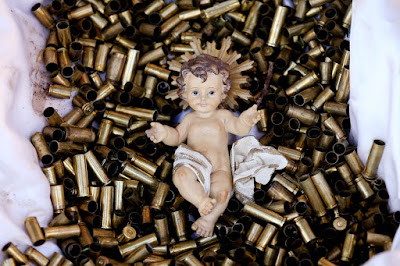Franciscan monks put baby Jesus on bed of bullets to press for peace
A statue of Infant Jesus on a bed of bullet shells is seen in a nativity scene outside the Basilica of St Francis in Assisi, Italy.
Franciscan monks have put the baby Jesus in a crib made of bullet shells in a yearly “provocation” nativity scene designed to draw attention to those suffering in the world.
Each year the monks choose a different theme for the nativity scene as part of what they call a “provocation” to underscore the need for peace, he said.
"People of peace, people of dialogue are killed, tortured and massacred for peace because they want to change the unjust systems in many societies," said Father Enzo Fortunato, a senior monk at the basilica and convent complex.
The 445 shells represent the number of priests, nuns, monks and religious teachers killed for their faith since 2000.

The successors of St Francis of Assisi, who invented the nativity scene, craft a different scene each year outside the basilica in the hill city of Assisi, the burial place of the 13th century patron saint of peace and the environment.
Last year they made the scene using stones from the Basilica of St Benedict in Norcia, also in the Umbria region, which had collapsed after a series of earthquakes that killed about 300 people.
The year before that they had made it from the remains of a boat that had carried migrants and refugees across the Mediterranean.
